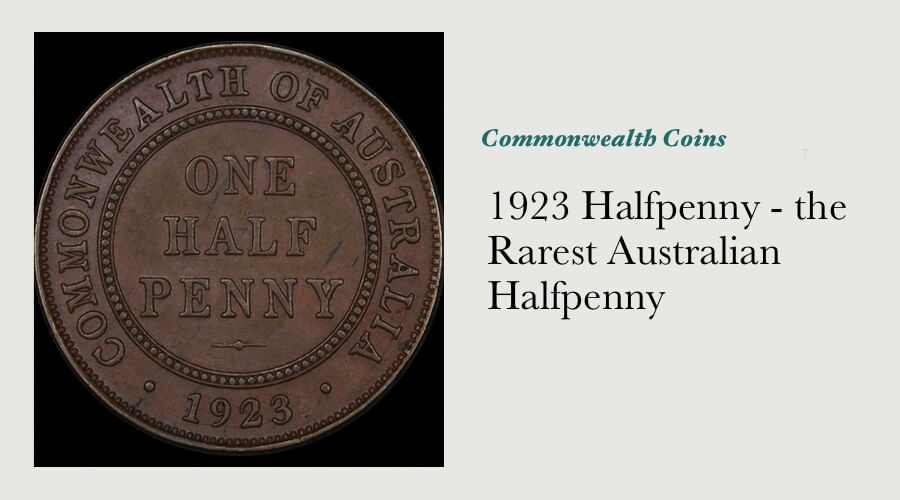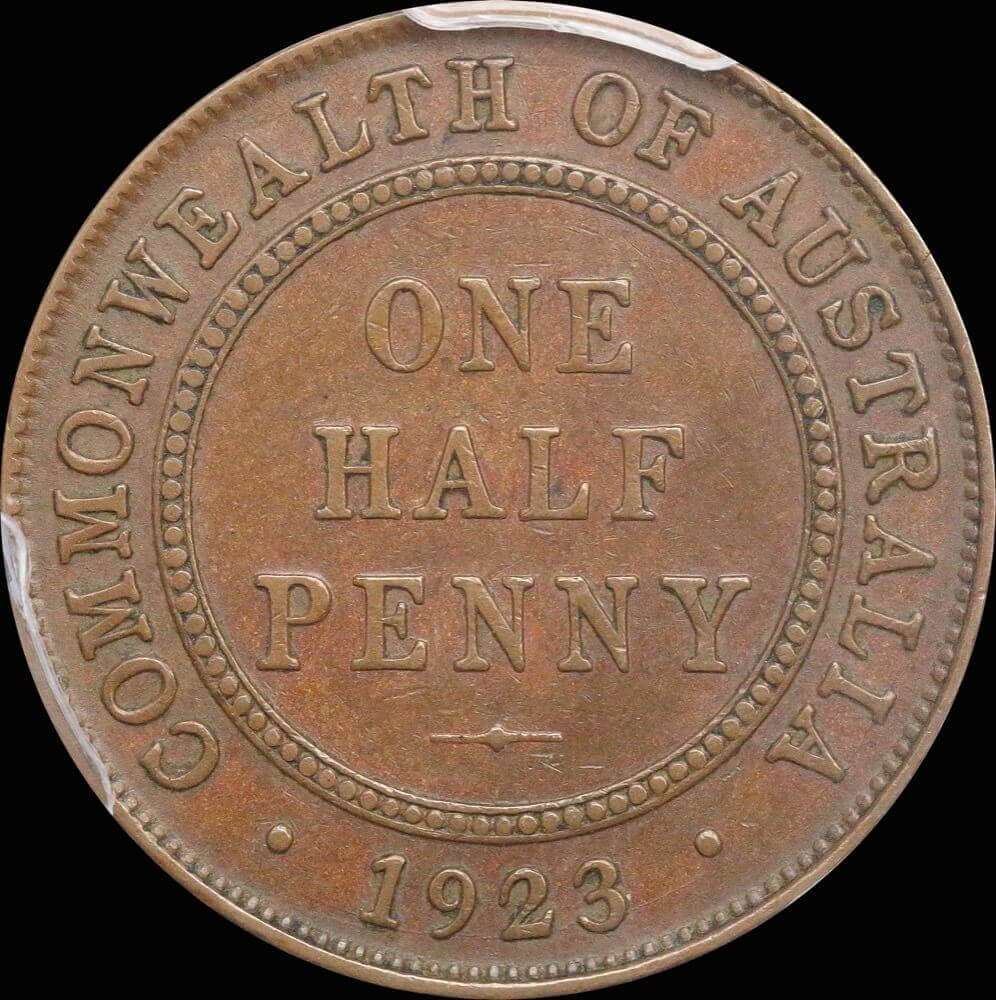1923 Halfpenny - the Rarest Australian Halfpenny

The 1923 half-penny is one of Australia’s rarest pre-decimal coins, produced in an era of economic growth and industrial turmoil.
It has been highly sought after by collectors for many years, and has a somewhat mysterious background - the real story behind its rarity remained untold for decades. Discerning collectors recognise that it is extremely difficult to find in superior quality.
1923 Royal (Branch) Mint records indicate that 1,113,600 halfpennies were struck in Sydney, while none were struck in Melbourne at all.
The story does not end here, as later research by John Sharples, (Numismatic Curator of the Museum of Victoria) has proven that the coins struck in Sydney in 1923 were actually dated 1922.
The elusive 1923 halfpenny was actually struck in Melbourne sometime between September and November 1923, with the number struck assumed to be around 20,000.
On July 10th 1923, the Commonwealth Treasury placed an order for 480,000 half pence. Three pairs of dies were prepared to do the job, but one of these was returned “for further work”.
Given that around 80,000 sovereigns were being produced from each pair of dies during this period, 2 pair of dies would surely have completed far less than a third of the total required. Why were so few dies ordered?

Why were so few coins struck with this date?
Although it had issued pence since 1919, 1923 was the first year Treasury had requested half pence from Melbourne. Coincidentally, it was also the first time that Melbourne was permitted to assist in producing dies for the full range of Commonwealth denominations.
Melbourne was now able to re-punch partially blank master dies with the final digit required for that year - for example, a reverse die dated “192_” was sent from London, to which a “3” or “4” was manually added. In true colonial style, it seems the Mint was keen to demonstrate its skill in minting this latest denomination at the British Empire Exhibition in London in 1924.
As the exhibition was to be held in 1924, the most impressive display would surely have been a complete set of coins dated 1924.
A set of unmatched coins (ie: one which included a halfpenny dated 1923) would not have anywhere near the same visual impact.
Australian Mints Faced Uncertain Future In The 1920s
To put this enthusiasm in context, each of the Australian mints faced an uncertain future in the 1920s. Demand for sovereigns eased with declining gold production, and competition for Commonwealth coinage contracts was also evident.
In short, the Melbourne mint would have been keen to demonstrate any ability or initiative that would help stave off an inevitable closure or give it a leg up over Sydney and Perth.
Keeping this in mind, perhaps the 1923 dies were used merely for testing. Varying striking pressures (the upper and lower limits of power required to achieve strong design detail) would have been firmly established by a trial run.
Once this “trial run” was finished, the limited number of 1923 dies would have provided the perfect excuse for them to request 1924 dies. This was the date required to complete the 1924 London Exhibition set, and as they would have now had the machinery at appropriate settings, it could be produced to a degree of quality easily acceptable internationally.
The 1923 halfpennies may have then been thrown aside, to be issued at a later date together with the next production run. Quite predominant hairline cracks (far greater than on the majority of Commonwealth coinage) indicate that the dies were subjected to great stress during production.
Their existence would not have been recorded in official figures, as this would certainly not have been correct Mint procedure.
The last thing Mint staff would have wanted is their superiors becoming aware of the “short-cuts” they had taken to attract recognition - in fact this would probably have been a major black mark against them in their tussles with the Sydney and Perth mints.
For many years this coin slipped through the cracks of Australian numismatic history - perhaps it should be known as the coin that never was! It is only due to avid collectors in later years that we are even aware of it today.
It remains a unique reminder of an era when Australia was undergoing tremendous economic turmoil - an era when public servants would cut corners to attract the attention of their superiors.
What Should I Look For When Selecting A 1923 Half-Penny?
A budding collector may ask, “What should I look for when selecting a 1923 half-penny?” While any authentic example will “fill the gap”, certain coins have more appeal than others and will remain in demand with a wider market in coming years.
.jpg)
A brief analysis of the wear properties of King George V halfpennies (and 1923 in particular) will give us some idea of what to look for in a superior quality coin.
As a starting point, let us assume that most coins from the depression era were actually used from day to day, and it is only by chance that a coin was able to avoid the ravages of circulation.
Australia’s numismatic community was extremely slender in the early part of this century - the number of active collectors would not have held a candle to the number involved today. Accordingly, the number of coins that would have been set aside with care would have to be negligible.
Perhaps an equal number of coins would have managed to “fall between the cracks” and somehow escaped attention, remaining largely pristine.
The balance of the original mintage (99.99%?) would have remained a part of Australia’s currency until they became damaged or worn beyond repair, perhaps until the changeover to the decimal system in 1966.
This would mean that most of these coins circulated for several decades at the least and upwards of 40 years at the outside. A brief perusal of the average quality of the coins remaining in existence bears testament to this - while a small number of coins show signs of having led an active life, the vast majority have aged gracefully.
A very small number have held up to the test of time better than others.
Looking at a sample of graded coins, we see that most grade between “Fine” and “Very Fine”. A number have been damaged or affected by poor storage (ie those graded lower than “Fine”, while the population really begins to taper off at “good VF” and better.
Patient collectors (with a modicum of funds) who are looking to add this Australian rarity to their collection would do well to seek out an example that is graded “good VF” or better.
Such a coin will exhibit the following traits:
- Rims intact and free of nicks or dents;
- Fields devoid of marks; scratches or corrosion;
- Lustre should be a pleasing light to dark brown, even in appearance and pleasing to the eye.
- The design should be reasonably well struck - the majority of detail remaining, particularly in the portrait.
- A full band should be seen on the base of the king’s crown.
- The centre diamond should also be seen distinctly - all four corners evident without blurring.
- There should also be 8 pearls evident in this crown band, with the 2 pearls to the left of the centre diamond slightly blurred.
In summary, a good VF (or better) 1923 half penny will be an attractive example of one of Australia’s pre-decimal rarities.
It has a fascinating history, and as the rarest date in the series, it will be in demand with date collectors for years to come. Above all, the 1923 halfpenny will forever remain as a reminder of an era when Australia was undergoing tremendous economic growth and turmoil, an era when the approval of a far-off Mint Master remained paramount.
How to Detect a Counterfeit of the 1923 Halfpenny
When determining a coin’s authenticity, a sound starting point is to define the technical characteristics of that issue: Which obverse die was used? Which reverse die was used? What unique nuances does this coin have?
Obverse: Just one obverse hub or master die was used to create obverse dies for all halfpennies struck in Australia during the King George V period (between 1911 and 1936).
The obverse dies used to strike the 1916 "Mule" is of course rather different!
The standard KGV obverse on Australian halfpennies exhibits the following features: 156 beads in the rim; the last stroke of N in OMN is aligned between rim beads; the semicolon after IMP is aligned with the rim bead. (See photograph.)
Reverse: Prepared in Melbourne from London masters, with the numbers in the date re-punched in Melbourne. (See photograph.)
Nuances: The 2 in the date is typical of other coins struck using London sourced dies - there is a distinct vertical downward hook to the upper-left stroke.
The upward flick on the right-hand side of the base is also quite high relative to those struck later.
The 3 in the date has a shorter, thicker bottom stroke to those struck elsewhere - it differs from those coins whose dates were re punched with differently styled numbers.
Only 25% of remaining specimens are completely devoid of die cracks, with the balance of 75% showing die cracks that fall into two distinct categories. (See photographs.)
What Is the Value of a 1923 Halfpenny?
Estimated prices of the 1923 halfpenny:
| Condition | Price |
|---|---|
| Good | $495 |
| Fine | $950 |
| Very Fine | $1,250 |
| Extremely Fine | $5,000 |
| About Uncirculated | $15,000 |
| Uncirculated | $25,000 |
